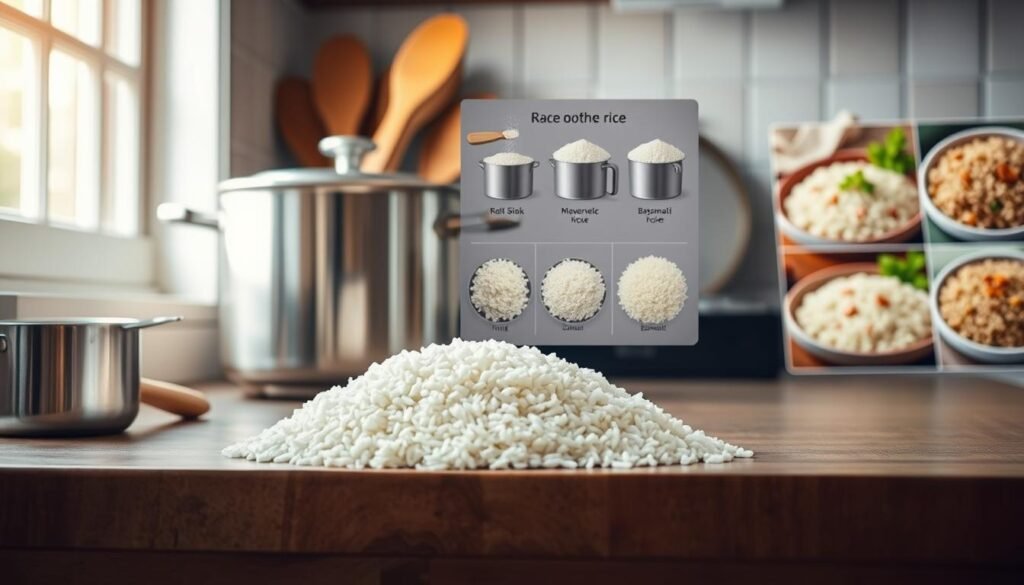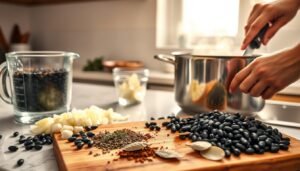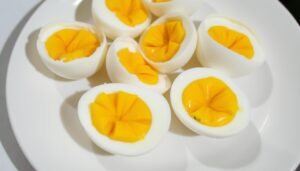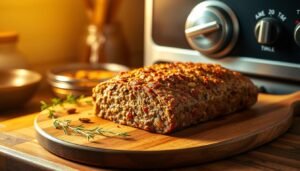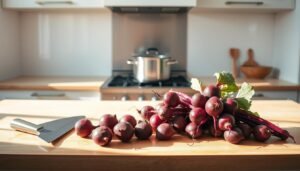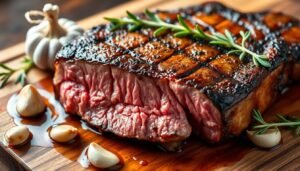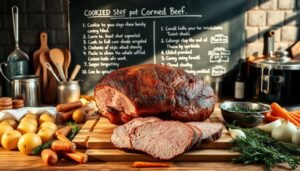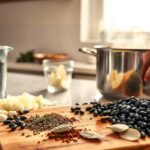Did you know over half of the world eats rice every day? It’s not just a side dish. This versatile grain is key to many cuisines worldwide. In this guide, I’ll show you how to cook rice perfectly, making it a great addition to any meal.
Whether you’re new to cooking or an expert looking for new recipes, I’ve got you covered. Let’s start this culinary adventure together!
Key Takeaways
- Rice is a staple food for more than half of the world’s population.
- Mastering how to cook rice can enhance your meals significantly.
- There are various types of rice, each suited for different dishes.
- Using the right tools can make cooking rice much easier.
- Adjusting the rice-to-water ratio is crucial for perfect texture.
- Washing and soaking rice can improve its flavor and consistency.
- Common cooking mistakes can be avoided with a little knowledge.
Understanding Different Types of Rice
Exploring the variety of types of rice can make cooking more fun. Each type has its own texture and flavor. Knowing the differences between long grain, short grain, white, and brown rice helps with meal planning.
Long Grain vs. Short Grain
Long grain rice, like Basmati or Jasmine, cooks up thin and fluffy. It’s great for pilafs or salads. Short grain rice, used for sushi, cooks stickier and clumps together. This makes it perfect for sushi rolls or rice balls.
White Rice vs. Brown Rice
White rice is soft and delicate, thanks to its refining process. It’s versatile and goes well with many dishes. Brown rice, with its bran and germ, is chewier and healthier. It’s full of fiber and nutrients.
Arborio, Jasmine, and Basmati
Some rice types are special because of their uses. Arborio rice is high in starch, making creamy risottos. Jasmine rice has a floral aroma, perfect for Southeast Asian dishes. Basmati rice has a nutty flavor and aroma, adding an exotic touch to meals, often in Indian cuisine.
Essential Tools for Cooking Rice
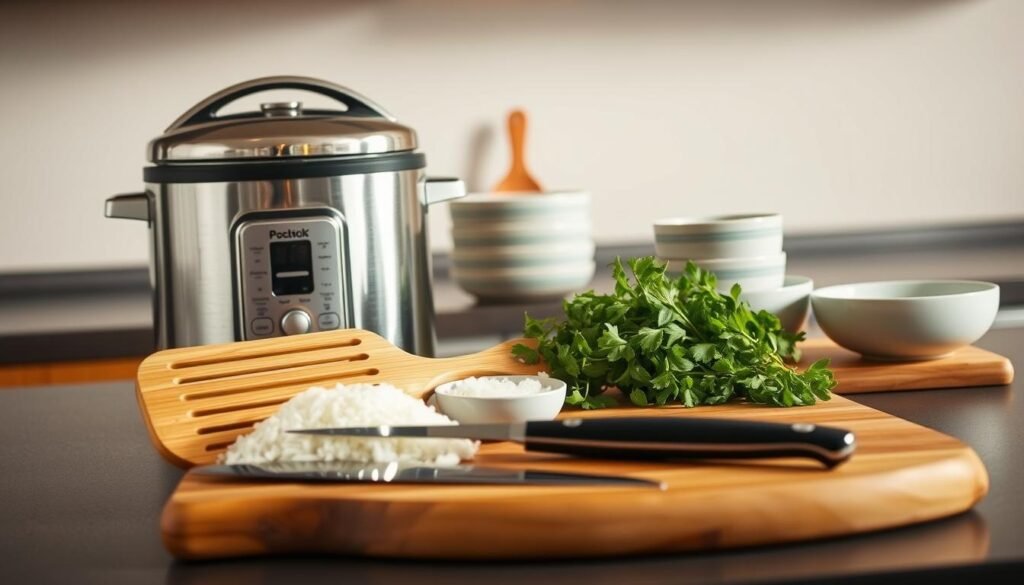
Cooking rice can be a fun experience with the right tools. Using the right kitchen tools makes cooking rice better. Whether you’re new or experienced, having the right tools can make a big difference.
Basic Kitchen Tools
For cooking rice, you need a few basic tools. These include:
- Large pot with a lid
- Wooden spoon or spatula
- Strainer for rinsing rice
These tools help cook rice evenly and make it easy to handle. This way, I always get fluffy rice.
Rice Cookers: Are They Worth It?
Thinking about getting a rice cooker? The benefits are clear. They make cooking rice easy and convenient. You can set it and forget it, freeing you to do other things.
Rice cookers also prevent overcooking and burning. They come with timers and keep-warm functions, making them even more useful.
Measuring Cups and Spoons
Measuring rice accurately is key. Using the right measuring cups and spoons is important. I always have both dry and liquid measuring tools ready.
This ensures my rice dishes always taste great. Without the right measurements, it’s hard to get the perfect texture and flavor.
The Perfect Rice-to-Water Ratio
Getting the rice-to-water ratio right is key for perfect cooked rice. The basic rule is one cup of rice to two cups of water for long-grain white rice. But, the ratio changes with different rice types. So, it’s important to follow specific cooking guidelines for rice to match your dish and taste.
General Guidelines for Cooking Rice
Through years of cooking rice, I’ve found that the right technique is crucial. Here’s a simple guide to help:
- Long-Grain White Rice: 1 cup rice to 2 cups water
- Brown Rice: 1 cup rice to 2.5 cups water
- Jasmine Rice: 1 cup rice to 1.5 cups water
- Arborio Rice: 1 cup rice to 4 cups water (or broth for extra flavor)
Adjusting Ratios for Different Types
Different rice types absorb water differently. For example, brown rice needs more water because of its harder exterior. Here’s a table showing water needs for various rice types:
| Type of Rice | Rice-to-Water Ratio |
|---|---|
| White Rice | 1:2 |
| Brown Rice | 1:2.5 |
| Jasmine Rice | 1:1.5 |
| Arborio Rice | 1:4 |
Tips for Flavorful Rice Cooking
For flavorful rice, rinse your rice before cooking. This removes excess starch for a lighter, fluffier dish. Adding a pinch of salt or a splash of olive oil can also enhance flavor. For an even richer taste, use broth instead of water.
Washing and Soaking Rice
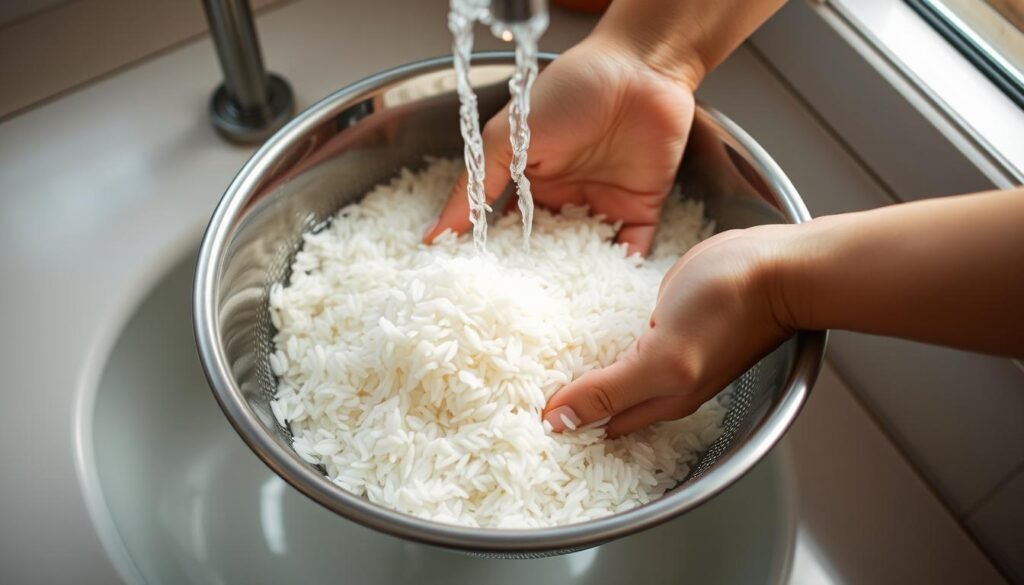
Washing and soaking rice are key steps in making perfect rice. These steps improve the rice’s quality, flavor, and overall taste. I always stress their importance.
Why Wash Rice?
Washing rice gets rid of extra starch and dirt. This makes the rice cook evenly, becoming lighter and fluffier. It also prevents the rice from sticking together, making each grain stand out.
How to Properly Wash Rice
To wash rice well, put it in a bowl and cover it with cold water. Move the grains around with your hand until the water gets cloudy. Then, drain and repeat until the water is clear. This method ensures clean rice for cooking.
Soaking for Better Texture
Soaking rice improves its texture. For long-grain rice, soaking for 30 minutes or more is best. It helps the rice cook evenly and makes it tender. After soaking, the rice is ready for cooking, making for a great meal.
Cooking Methods for Rice
There are many ways to cook rice, each with its own benefits. You can choose the stovetop method, use a rice cooker, or try the Instant Pot. Let’s look at each option and see which one fits your needs best.
Stovetop Cooking
Stovetop rice gives you full control over the cooking process. You boil the rice and water together, then simmer until the water is gone. It takes some attention, but it’s worth it for perfect rice every time.
Using a Rice Cooker
If you’re always on the go, a rice cooker is a great choice. Just put in the rice and water, pick a setting, and let it cook. It makes cooking rice easy and ensures your rice is always perfect.
Instant Pot Method
The Instant Pot is fast and efficient for cooking rice. It uses high pressure to cook rice quickly without losing its texture. It’s great for when you’re short on time, like on busy weeknights.
| Method | Time | Level of Control | Best For |
|---|---|---|---|
| Stovetop Cooking | 20-30 minutes | High | Traditionalists |
| Rice Cooker | 25-40 minutes | Medium | Convenience Seekers |
| Instant Pot | 10-15 minutes | Low | Efficiency Fans |
Flavoring Your Rice
Cooking rice is more than just getting the right texture; flavoring rice makes it special. I enjoy trying out different herbs, spices, and cooking ways to make my rice taste amazing. Here are some tips to help you do the same.
Herbs and Spices to Enhance Taste
For a richer taste, I use herbs and spices. Garlic, bay leaves, and turmeric add deep flavors. Adding fresh basil or parsley not only tastes great but also looks good.
Broth vs. Water for Cooking
Using broth instead of water is a trick I love. Chicken, beef, or vegetable broth adds a unique taste. This simple change makes rice with broth a tasty side dish that goes well with many meals.
Adding Vegetables and Proteins
To make my rice meals better, I add veggies and proteins. Carrots, peas, and bell peppers add color and nutrients. Adding chicken, shrimp, or tofu makes the rice a filling meal. This way, I get a meal that’s both healthy and tasty.
Common Mistakes to Avoid
Many home cooks face the same challenges when cooking rice. Knowing these issues can help you avoid a less-than-ideal dish. Let’s look at the most common mistakes, like overcooked and undercooked rice, that people make.
Overcooking or Undercooking
Getting the rice just right is a big challenge. Overcooked rice becomes mushy and loses its texture. Undercooked rice is hard and unpleasant to eat. It’s important to follow the cooking times for your rice type closely.
Not Using Enough Water
Not using enough water is another common mistake. This can make the rice dry and flavorless. Using the right amount of water is key for even cooking and better taste.
Stirring Too Much While Cooking
Stirring rice too much can make it sticky and gummy. It’s better to wait until it’s fully cooked before fluffing it. This way, the rice absorbs flavors better without becoming clumpy.
Troubleshooting Your Rice
Cooking rice can sometimes be tricky. But, with the right solutions, you can fix common issues. Whether it’s sticky rice, burnt rice, or too much water, I’ve got tips to help you achieve the perfect bowl.
Fixing Sticky Rice
For sticky rice, try spreading it on a baking sheet to cool. This lets steam escape and breaks up clumps. Also, rinsing the rice before cooking can help. It removes excess starch, making the rice fluffier.
How to Rescue Burnt Rice
Burnt rice is a common problem. To fix it, scoop out the good rice and move it to a new pot. If the burnt taste remains, place a slice of bread on top. Cover it for a few minutes. The bread absorbs the burnt flavor.
What to Do with Too Much Water
Too much water in rice can be a challenge. Try draining off the excess water carefully. Make sure not to lose any rice. If you’re feeling bold, cook the rice a bit longer. This helps it absorb the water, making it fluffy.
Creative Rice Recipes to Try
Mastering rice cooking is just the start. Then, it’s time to get creative! Fried rice is a great way to use leftovers. It’s easy to mix different ingredients to match your taste.
Classic Fried Rice
Fried rice is more than just a meal; it’s a blank canvas. I add scrambled eggs, chicken, or shrimp. Fresh peas and carrots, soy sauce, and green onions make it special.
Rice Pilaf Variations
Rice pilaf is another favorite. It’s perfect for any occasion. I add nuts, dried fruits, and spices to make it unique. It’s a mix of textures and flavors that makes any meal better.
Unconventional Rice Desserts
Rice is also great in desserts. Try creamy rice pudding or coconut sticky rice with mango. These desserts show rice’s sweet side. Rice can be the main attraction in sweet dishes!


